United States
Department of
Agriculture
Forest Services
Technology &
Development
Program
7700—Transportation Systems
2500 Watershed & Air Mgmt
September 2000
0077 1803—SDTDC

|
Water/Road Interaction
Field Guide
|
Water/Road Interaction Field Guide
Water/Road Interaction Core Team
Introduction
The purpose of the Guide is to:
- Provide an illustrated field-going guide of observable water/road interaction problems damaging to road, watershed condition, water quality, aquatic life, or public safety;
- Increase awareness of how road location, design, maintenance, and management affect interactions with rainfall, runoff, and ground water;
- Facilitate communication on water/road interaction problems among professionals and technicians in a variety of physical and biological science disciplines and fields of engineering;
- Improve recognition of basic road drainage problems, and the ability to identify and verify likely causes;
- Increase awareness of possible alternative treatments to mitigate existing problems;
- Develop knowledge and experience required to conceptualize road segment characteristics that provide desired safe access with minimal affect to watershed, water resources, and aquatic life;
- Help inform line officer decisions.
Many drainage problems on low volume roads begin with surface water concentration and flow. Other problems involve road/stream crossings. Below are some contrasts, illustrated by the guide, between desirable conditions and those in which damage is occurring to road and/or watershed:
- Desired: Roadway surfaces are sufficiently drained such that water flows do not concentrate volume or erosive energy levels causing access, safety, maintenance, or environmental problems;
- Damaging: Roadway surfaces exhibit water concentration and erosion, with rills or gullys present over substantial areas. Wheel ruts present in the traveled way channel flow. The road prism is entrenched into the landscape;
- Desired: Roadway surfaces are sufficiently treated such that concentrated flows do not leave the prism with volume or energy sufficient to cause gullys to adjacent areas or other mass erosion;
- Damaging: Adjacent areas exhibit gullys that are not associated with the unroaded landscape condition. Sediment has been deposited in drainage ways and streams downslope of the road;
- Desired: Road/stream crossings are designed to adequately duplicate naturally occuring conditions for passage of water, debris, bedload, and aquatic organisms, and do not exhibit diversion potential;
- Damaging: Passage of one or more of the required entities is constricted, and diversion potential exists.
An electronic version of the draft Water/Road Interaction Field Guide is available on the San Dimas Technology and Development Center’s intranet web page. Navigate to Engineering, then Water/Road. The Field Guide link refers to a “work in progress.”
The Water/Road Interaction Field Guide is based on observable water/road interactions in ten major problem areas. These problem areas are:
- Surface water concentration problems on the traveled way;
- Surface water concentration problems on the backslope;
- Surface water concentration problems on the fillslope;
- Ditch or lead out ditch problems;
- Subsurface flow interception by the prism;
- Surface cross drain failure;
- Ditch relief culvert failure;
- Channel impacts/increased drainage density;
- Channel encroachments from road alignment in channel/flood plain;
- Road/Stream crossing problems.
Each of these ten problem areas contain multiple observations illustrated by photos. Each observation also provides:
- Important site/road conditions;
- Some possible treatments;
- A reference/definition aid, and
- A list of disciplines available to help recognize and analyze the problem.
Photos are captioned and show two scenarios: example observations of a water/road interaction problem on the ground, and situations in which the problem could occur, but does not, due to either nature or design. This is referred to in the Guide as Proper Drainage Provision.
Important road/site conditions are included with each observation as an aid to information gathering and to highlight critical conditions. The observer should consult with a specialist in the listed field for more information on critical conditions. Important site/road conditions are described as follows:
- Geology—includes parent material characteristics, soil properties, and slope stability;
- Climate—takes into consideration precipitation amounts, types, durations, intensities, and ambient temperatures;
- Topography—includes landform type, shape, and relief;
- Vegetation—involves types, characteristics, and ease of establishment;
- Biology—includes plant, animal, and fish considerations as affected by road drainage and road drainage structures;
- Template—refers to back and fillslope ratios and heights, traveled way surface shape and width, presence or absence of ditches and berms, and construction methods;
- Grade—road grade;
- Access—includes aspects of road location, road standards, maintenance, and vehicle considerations;
- Policy—refers to any external constraints imposed on transportation system development and activities other than those described above.
Important site/road conditions are included to help the observer gather and organize information needed to recognize and analyze the problem. This list is not exhaustive: other conditions may apply and required information gathering needs can vary considerably. Possible treatments listed are basic configurations. Many other options and specialized treatments exist to aid solution of water/road interaction problems but are beyond the scope of this guide. The observer should consult with the specialist listed for more information on possible treatments. References (in italics) are mainly related to documents in the Water/Road Interaction Technology Series binder. Basic definitions and a listing of specialties for consultation are also provided. Specialties include hydrology, biology, geology, forestry, engineering, geotechnical engineering, maintenance, and include the Interdisciplinary Team in general.
| Is |
Is Not |
| A mentoring, training, and general design aid for professionals and technicians in physical and biological science and engineering disciplines |
For specific design use by experienced professionals and technicians. |
| To facilitate use of the Water/Road Interaction Technology Series. |
A stand-alone document that is comprehensive in and of itself. |
| As simple and concise as is reasonably possible. |
An expert system. |
| A problem recognition and analysis tool. |
A problem correction tool. |
| For leading from observations to most likely causes or basic problems. |
For jumping from observation to treatment action. |
| For considering alternative treatments that could feasibly correct observed road drainage problems. |
For prescribing a selected treatment. |
| For facilitating communication and conceptual understanding among personnel. |
For selecting a specific course of action. |
| A field-going guide on low volume road drainage problems. |
An office bound reference. |
| For use within the scope of typical authority of entry level professionals. |
To encourage actions beyond typical authority or to bypass the decision making process. |
Surface Water Concentration Problems on the Traveled Way
Loss of Surface Material
| Important Site/Road Conditions |
Possible Treatments |
Specialist |
Reference/Definition |
Geology
Climate
Template
Grade
Access
Policy
|
Add surface cross drainage |
Engineer, Hydrologist |
The X-DRAIN Cross Drain Spacing and Sediment Yield Model, Cross Drain Update, Introduction to Surface Cross Drains |
| Modify template |
Engineer |
Traveled Way Surface Shape |
| Harden surface |
Engineer |
Pave, aggregate, vegetation, or chemical binder. |
|
LOSS OF SURFACE MATERIALS
|
|
PROPER DRAINAGE PROVISION
|

|

|
|

|

|
|
Surface water concentration and erosion on traveled way surface.
|
Entrenchment of traveled way surface to 0.4 m below surrounding terrain due to use, erosion, and surface blading.
|
|
Stable backslopes and fillslopes; well drained road surfaces.
|
Grass on road surface prevents loss of surface materials.
|
Gullying
| Important Site/Road Conditions |
Possible Treatments |
Specialist |
Reference/Definition |
Geology
Climate
Template
Grade
|
Add surface cross drainage |
Engineer, Hydrologist |
The X-DRAIN Cross Drain Spacing and Sediment Yield Model, Cross Drain Update, Introduction to Surface Cross Drains |
| Modify template |
Engineer |
Traveled Way Surface Shape |
| Harden surface |
Engineer |
Pave, aggregate, or chemical binder. |
| Remedial maintenance |
Maintenance Foreman |
Remove gullies, maintain traveled way surface and other drainage provision to avoid gully erosion. |
|
GULLYING
|
|
PROPER DRAINAGE PROVISION
|

|

|
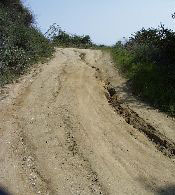
|
|

|
|
Gully formation on traveled way due to concentrated surface flow.
|
|
Stable backslopes and fillslopes; well drained road surfaces.
|
Rutting
| Important Site/Road Conditions |
Possible Treatments |
Specialist |
Reference/Definition |
Geology
Climate
Template
Access
Policy
|
Add surface cross drainage |
Engineer |
Drain subgrade to ensure bearing capacity for wheel loads |
| Harden surface |
Engineer |
Pave or apply aggregate. |
| Remedial maintenance |
Maintenance Foreman |
Remove ruts; drain traveled way. |
| Manage traffic |
Interdisciplinary Team |
Seasonal closure; use restrictions. |
| Open canopy |
Biologist, Engineer, Forester |
Remove vegetation; increase drying of traveled surface. |
|
RUTTING
|
|
PROPER DRAINAGE PROVISION
|

|

|
|
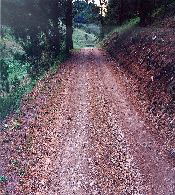
|
|
Rutting of traveled way surface due to saturation and wheel loads.
|
|
Well drained outsloped road resists rutting.
|
Sedimentation
| Important Site/Road Conditions |
Possible Treatments |
Specialist |
Reference/Definition |
Climate
Topography
Vegetation
Biology
Template
Grade
Access
|
Add surface cross drainage, isolate water concentrations |
Engineer, Hydrologist |
The X-DRAIN Cross Drain Spacing and Sediment Yield Model, Cross Drain Update, Introduction to Surface Cross Drains |
| Vegetative treatments, buffers |
Biologist, Forester, Range Conservationist |
Seeding, mulching, hydromulching, paper mulch, biotechnical treatments. |
| Remedial maintenance |
Maintenance Foreman |
Treat eroding surfaces and design drainage provision to avoid gully erosion. |
|
SEDIMENTATION
|
|
PROPER DRAINAGE PROVISION
|

|

|

|
|

|
|
Sedimentation on traveled way due to material eroded from higher on the road grade.
|
Surface water concentration on road washes light cinder surfacing through lead out ditch to be deposited in meadow.
|
Material deposited on traveled way, eroded from upslope on the road, and subsequently removed and piled here during maintenance operations.
|
|
Grass on road prism prevents loss of surface materials.
|
Ponding
| Important Site/Road Conditions |
Possible Treatments |
Specialist |
Reference/Definition |
Geology
Climate
Topography
Template
Grade
Access
|
Add surface cross drainage |
Engineer |
Cross Drain Update |
| Modify template |
Engineer |
Traveled Way Surface Shape |
|
PONDING
|
|
PROPER DRAINAGE PROVISION
|

|

|
|

|

|
|
Ponding.
|
Ponding on the traveled way.
|
|
Stable backslopes and fillslopes, well drained road surfaces.
|
Porous road fill prevents ponding problems on the traveled way.
|
Berms
| Important Site/Road Conditions |
Possible Treatments |
Specialist |
Reference/Definition |
Climate
Topography
Vegetation
Template
Access
Policy
|
Remove berm |
Engineer, Hydrologist |
Traveled Way Surface Shape |
| Excavate drainage path through berm |
Engineer, Hydrologist |
Outslope and provide drainage path or lead out ditch for surface flow over downhill shoulder. |
| Adjust snow removal practices |
Engineer, Hydrologist |
Ensure snow removal practices do not result in berms or surface water concentration on the road prism. |
|
BERMS
|
|
PROPER DRAINAGE PROVISION
|

|

|

|
|

|
|
Large berm increases distributed width of road and acts to keep water channeled on traveled way.
|
Insloped traveled way with large berm on outside shoulder. Note the existence of rills running perpendicular to road center line even after surface blading.
|
Berm left during snow plowing can lead to surface water concentration on the traveled way.
|
|
Berm removal allows surface flow over downhill shoulder.
|
Surface Water Concentration Problems on the Backslope
Erosion
| Important Site/Road Conditions |
Possible Treatments |
Specialist |
Reference/Definition |
Geology
Climate
Topography
Vegetation
Template
|
Vegetation, increase cover |
Biologist, Forester, Engr, Range Conservationist |
Seeding, mulch, hydromulch, papermulch, geosynthetic, biotechnical. |
| Modify slope |
Engineer |
Reduce slope, serrate, bench. |
| Harden surface |
Engineer |
Rock rip-rap, check dams. |
| Dispurse flow from above backslope |
Engineer, Hydrologist, Forester |
Ditch and/or berm. |
|
EROSION
|
|
PROPER DRAINAGE PROVISION
|

|
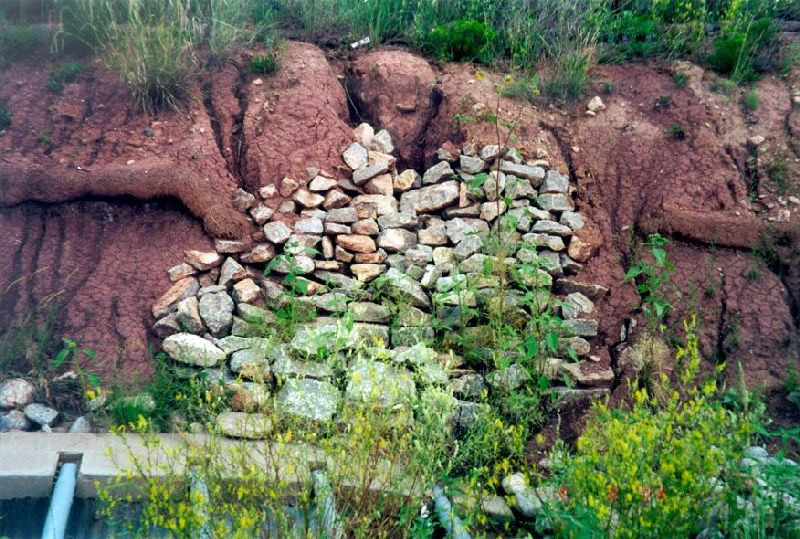
|
|

|

|
|
Backslope erosion and deposition of material on traveled way.
|
Surface water concentration from above causing erosion of backslope: attempt to harden slope.
|
|
Erosion susceptable backslope armored with rock rip-rap.
|
Rolled hay bales placed at intervals on the backslope to reduce water concentrations and erosion.
|
Slides on the Backslope
| Important Site/Road Conditions |
Possible Treatments |
Specialist |
Reference/Definition |
Geology
Climate
Topography
Vegetation
Template
Access
Policy
|
Modify slope, template |
Geotechnical Engineer |
Reduce slope, bench, retaining walls. |
| Modify weight distribution |
Geotechnical Engineer |
Rock buttress. |
| Bioengineering |
Engineer, Biologist |
Mechanical plus vegetative treatments. |
|
SLIDES ON THE BACKSLOPE
|
|
PROPER DRAINAGE PROVISION
|
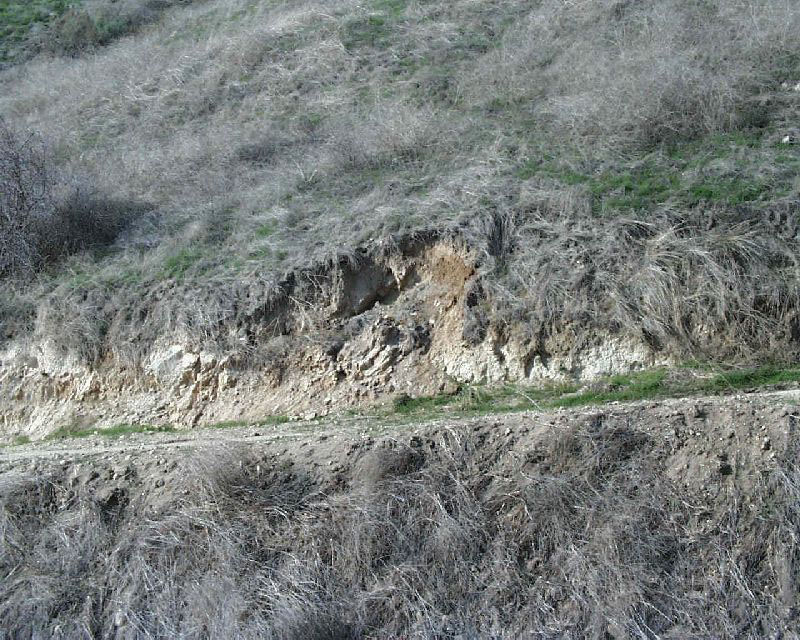
|
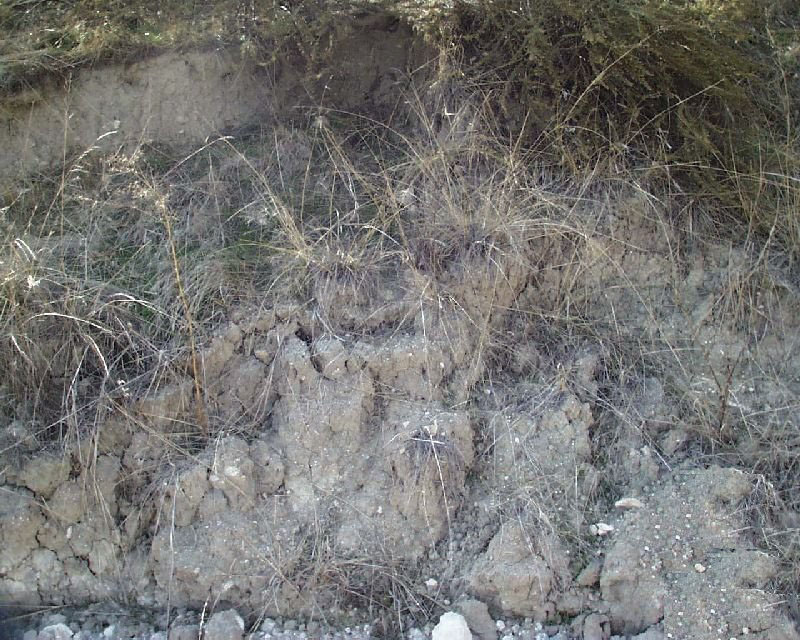
|
|

|

|
|
Slumping backslope failure.
|
Slumping failure on the backslope.
|
|
Stable, well vegetated backslope.
|
Rock filled gabion basket protection on backslope.
|
Slides Extending Above Backslope
| Important Site/Road Conditions |
Possible Treatments |
Specialist |
Reference/Definition |
Geology
Climate
Topography
Vegetation
Template
Access
Policy
|
Consultation |
Geotechnical Specialist |
N/A |
|
SLIDES EXTENDING ABOVE BACKSLOPE
|
|
PROPER DRAINAGE PROVISION
|

|

|

|
|

|
|
Material above top of cut slope available for transport down to traveled way surface.
|
Material deposited on traveled way from a slide extending above the top of cut.
|
Hillslope above backslope sliding onto traveled way surface.
|
|
Stable, well vegetated backslope.
|
Surface Water Concentration Problems on the Fillslope
Erosion
| Important Site/Road Conditions |
Possible Treatments |
Specialist |
Reference/Definition |
Geology
Climate
Topography
Vegetation
Template
Grade
|
Divert or disperse flow from upslope template, areas |
Engineer, Hydrologist |
Traveled Way Surface Shape, Introduction to Surface Cross Drains, the X-DRAIN Cross Drain Spacing and Sediment Yield Model |
| Establish vegetation |
Biologist, Forester, Range Conservationist |
Seed, mulch, plantings, biotechnical. |
| Armor surface |
Engineer |
Rock rip-rap, geosynthetics. |
| Adjust snow removal practices |
Engineer, Mtnc. Foreman |
Ensure practices do not lead to surface water concentrations. |
| Add over-side drains |
Engineer |
Drainage structure that protects fillslope from erosion. Caution: can increase erosive energy of water flow. |
|
EROSION
|
|
PROPER DRAINAGE PROVISION
|

|

|
|

|

|
|
Surface water concentration on fillslope from grade dip outflow.
|
Erosion of fillslope due to concentrated surface flow.
|
|
Rock rip-rap protection on the fillslope.
|
Stable, well vegetated fillslope.
|
Tension Cracks
| Important Site/Road Conditions |
Possible Treatments |
Specialist |
Reference/Definition |
Geology
Climate
Topography
Vegetation
Template
Grade
Access
Policy
|
Consultation |
Geotechnical Specialist |
N/A |
|
TENSION CRACKS
|
|
PROPER DRAINAGE PROVISION
|

|
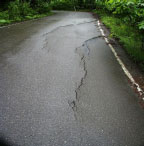
|
|

|
|
Tension crack in traveled way due to excessive weight of saturated embankment.
|
Tension cracks in asphalt surface due to embankment settlement.
|
|
Well drained outslope road resists tension cracking.
|
Slides
| Important Site/Road Conditions |
Possible Treatments |
Specialist |
Reference/Definition |
Geology
Climate
Topography
Vegetation
Template
Grade
Access
Policy
|
Consultation |
Geotechnical Specialist |
N/A |
|
SLIDES
|
|
PROPER DRAINAGE PROVISION
|

|
|

|

|
|
Over steepened fillslope slide.
|
|
Grouted rock retaining wall to stabilize fillslope.
|
Precast concrete log crib structure to stabilize fillslope.
|
Ditch or Lead Out Ditch Problems
Erosion
| Important Site/Road Conditions |
Possible Treatments |
Specialist |
Reference/Definition |
Geology
Climate
Topography
Vegetation
Template
Grade
|
Increase ditch relief |
Engineer, Hydrologist, Biologist |
Relief Culverts |
| Decrease flow contribution from traveled way |
Engineer, Hydrologist |
Traveled Way Surface Shape |
| Decrease flow contribution from backslope |
Engineer, Hydrologist |
Vegetation, biotechnical, or mechanical treatments to backslope. |
| Vegetation |
Biologist, Range Conservationist |
Seed with grasses suitable for ditch. |
| Harden or armor flow area |
Engineer |
Line ditch with rock rip-rap or aggregate, or use in ditch culvert. |
| Modify ditch geometry |
Engineer |
Widen and flatten flow path if possible, or add energy dissipators. |
|
EROSION
|
|
PROPER DRAINAGE PROVISION
|

|

|
|

|
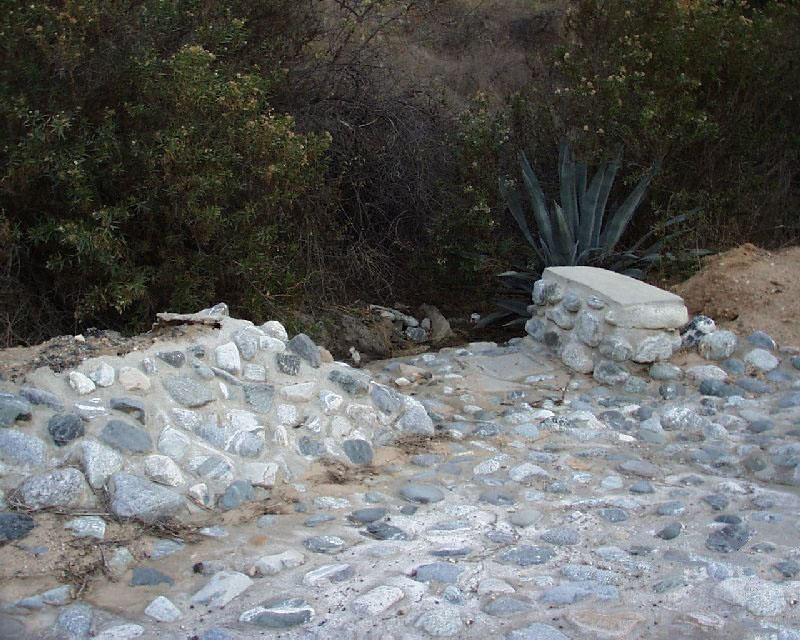
|
|
Erosion and downcutting of inboard ditch.
|
|
Ditch pavement to resist erosion and subsequent sedimentation.
|
Grouted rock lead out ditch resists erosion.
|
Sedimentation
| Important Site/Road Conditions |
Possible Treatments |
Specialist |
Reference/Definition |
Geology
Climate
Topography
Vegetation
Biology
Template
Grade
Access
Policy
|
Reduce upslope erosion |
Engineer, Hydrologist, Biologist |
Harden, vegetate upslope area. |
| Decrease flow contribution from traveled way |
Engineer, Hydrologist |
Traveled Way Surface Shape |
| Decrease flow contribution from backslope |
Engineer, Hydrologist |
Vegetation, geosynthetic or organic mat, structural treatments. |
| Modify ditch geometry, relief |
Engineer, Hydrologist |
Steepen flow path if possible. |
|
SEDIMENTATION
|
|
PROPER DRAINAGE PROVISION
|

|
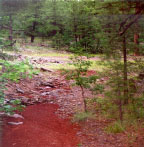
|
|

|

|
|
Clogging of ditch with sediment from upslope road segment.
|
Deposition, clogging of lead out ditch with light cinder surfacing washed from traveled way.
|
|
Properly functioning lead out ditch.
|
Well vegetated ditch reduces downstream sedimentation.
|
Backslope Undermining
| Important Site/Road Conditions |
Possible Treatments |
Specialist |
Reference/Definition |
Geology
Climate
Topography
Vegetation
Template
Grade
Policy
|
Harden ditch, in-ditch culvert |
Engineer |
Pave, line with rock, vegetate. In-ditch culvert prevents downcutting. |
| Modify ditch geometry |
Engineer |
Flatten flow path if possible. |
|
BACKSLOPE UNDERMINING
|
|
PROPER DRAINAGE PROVISION
|

|
|

|

|
|
Undermining of backslope due to downcutting of ditch.
|
|
Paved ditch resists erosion and downcutting.
|
Well vegetated ditch reduces backslope undermining.
|
Subsurface Flow Interception by the Prism
Prism Saturation
| Important Site/Road Conditions |
Possible Treatments |
Specialist |
Reference/Definition |
Geology
Climate
Topography
Template
Access
Policy
|
Direct flow underneath road surface in french drain |
Engineer, Hydrologist |
French drain, aggregate, and geotextile or geocomposite. |
| Direct flow underneath road surface in porous fill |
Engineer, Hydrologist |
Large, uniformly graded rocky fill with riding surface cap. |
| Seal or harden riding surface |
Engineer |
Pavement, aggregate. |
| Install low water crossing |
Engineer, Hydrologist |
Subgrade designed to support wheel loads and survive overtopping flows. |
|
PRISM SATURATION
|
|
PROPER DRAINAGE PROVISION
|

|

|
|
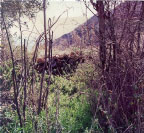
|

|
|
Backslope seepage causing saturated road subgrade.
|
|
View of porous fill built over area saturated by exfiltration of subsurface flow.
|
Porous fill prevents prism saturation problems due to intercepted subsurface flow.
|
Erosion/Rutting
| Important Site/Road Conditions |
Possible Treatments |
Specialist |
Reference/Definition |
Geology
Climate
Template
Grade
Access
Policy
|
Direct flow underneath road surface in french drain |
Engineer, Hydrologist |
French drain, aggregate, and geotextile or geocomposite. |
| Direct flow underneath road surface in porous fill |
Engineer, Hydrologist |
Large, uniformly graded rocky fill with riding surface cap. |
| Harden riding surface |
Engineer |
Pavement, aggregate. |
| Install low water crossing |
Engineer, Hydrologist |
Traveled way designed for overtopping flows. |
|
EROSION/RUTTING
|
|
PROPER DRAINAGE PROVISION
|

|
|

|
|
Erosion and rutting potential due to subsurface flow interception by the prism.
|
|
Porous fill provides hardened riding surface to resist erosion and rutting.
|
Ponding
| Important Site/Road Conditions |
Possible Treatments |
Specialist |
Reference/Definition |
Climate
Topography
Template
Grade
Access
Policy
|
Direct flow underneath road surface in french drain |
Engineer, Hydrologist |
French drain, aggregate, and geotextile or geocomposite. |
| Direct flow underneath road surface in permeable fill |
Engineer, Hydrologist |
Large, uniformly graded rocky fill with riding surface cap. |
| Install low water crossing |
Engineer, Hydrologist |
Traveled way designed for overtopping flows. |
| Modify template |
Engineer |
Traveled Way Surface Shape |
|
PONDING
|
|
PROPER DRAINAGE PROVISION
|

|

|
|

|
|
Ponding problems due to subsurface flow interception by the prism.
|
Ponding problem on traveled way due to intercepted subsurface flow.
|
|
Built-up porous fill relieves ponding problems by providing drainage in areas exhibiting exfiltration of subsurface flow.
|
Surface Cross Drain Failure
Erosion of Cross Drain
| Important Site/Road Conditions |
Possible Treatments |
Specialist |
Reference/Definition |
Geology
Climate
Template
Grade
Access
|
Add surface cross drainage |
Engineer, Hydrologist |
The X-DRAIN Cross Drain Spacing and Sediment Yield Model, Cross Drain Update, Introduction to Surface Cross Drains |
| Minimize contributing drainage areas |
Engineer, Hydrologist |
Reduce area contributing surface flow with vegetation, organic material, or geosynthetics. |
| Isolate contributing drainage areas |
Engineer, Geologist |
Keep surface flows from individual contributing areas from accumulating. |
| Clean/maintain/restore cross drain |
Maintenance Foreman |
Restore cross drain function. |
| Harden drain area |
Engineer |
Provide erosion proof or resistant flow path. |
| Vegetation |
Biologist, Forester, Range Conservationist |
Seed, mulch, or plantings. |
|
EROSION OF CROSS DRAIN
|
|
PROPER DRAINAGE PROVISION
|

|

|
|

|

|
|
Erosion of grade dip.
|
|
Grouted rock lead out ditch resists erosion.
|
Uniformly graded rock used to armor cross drain.
|
Deposition
| Important Site/Road Conditions |
Possible Treatments |
Specialist |
Reference/Definition |
Geology
Climate
Topography
Vegetation
Template
Grade
Access
|
Add surface cross drainage |
Engineer, Hydrologist |
The X-DRAIN Cross Drain Spacing and Sediment Yield Model, Cross Drain Update, Introduction to Surface Cross Drains |
| Clean/maintain/restore cross drain |
Maintenance Foreman |
Restore cross drain function. |
| Harden/armor upslope surface |
Engineer, Geologist |
Reduce erosion from upslope areas to reduce downstream deposition. |
|
DEPOSITION
|
|
PROPER DRAINAGE PROVISION
|
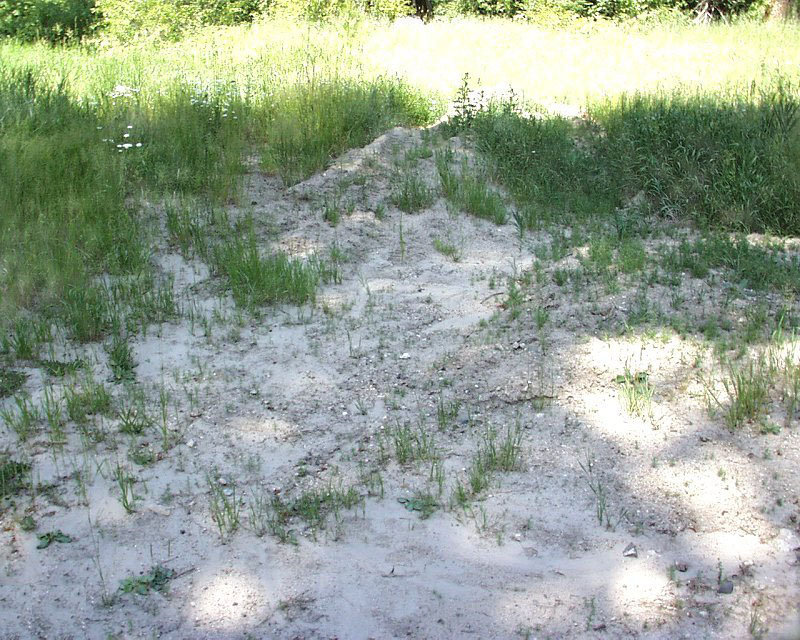
|

|
|

|
|
Filling in of grade dip outflow with sediment.
|
Deposition of light cinder road surfacing in meadow and clogging of lead out ditch.
|
|
Hardened upslope surface resists erosion, allowing this grade dip outflow to remain free flowing.
|
Bypassed Structure
| Important Site/Road Conditions |
Possible Treatments |
Specialist |
Reference/Definition |
Geology
Climate
Topography
Vegetation
Template
Grade
Access
|
Add surface cross drainage |
Engineer, Hydrologist |
The X-DRAIN Cross Drain Spacing and Sediment Yield Model, Cross Drain Update, Introduction to Surface Cross Drains |
| Deepen drainage structure (consult engineer) |
Engineer |
Ensure flow paths are directed into cross drain. |
|
BYPASSED STRUCTURE
|
|
PROPER DRAINAGE PROVISION
|

|

|
|

|
|
Bypassing of cross drain outflow due to deposition of sediment.
|
Bypassed lead out ditch due to insloped traveled way surface shape.
|
|
Lack of bypass problems on lead out ditch.
|
Ditch Relief Culvert Failure
Inlet Plugging
| Important Site/Road Conditions |
Possible Treatments |
Specialist |
Reference/Definition |
Geology
Climate
Topography
Vegetation
Template
Grade
Access
|
Remove inlet obstructions |
Maintenance Foreman |
Clean inlet, trash rack, or sedimentation pond. |
| Vegetate upslope area |
Biologist, Forester, Range Conservationist |
Seed or plant upslope area to reduce erosion. |
| Diversion prevention dip |
Engineer, Hydrologist |
Diversion Potential at Road/Stream Crossings |
| Maintain/clean ditch |
Maintenance Foreman |
Remove materials threatening inlet plugging. |
| Gully treatments |
Engineer, Hydrologist, Geologist |
Gully plugs or harden ditch. |
| Entrance treatments |
Engineer |
Enhance passage of debris. |
|
INLET PLUGGING
|
|
PROPER DRAINAGE PROVISION
|

|

|
|

|
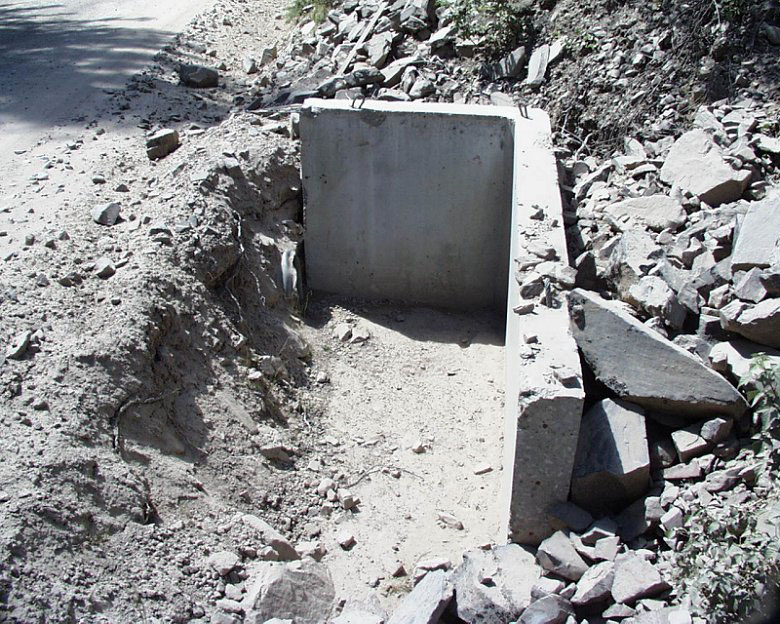
|
|
Ditch relief culvert subject to sediment plugging.
|
Ditch relief culvert on the verge of plugging due to sedimentation in inlet basin.
|
|
Cast in place concrete catch basin creates swirling action that flushes organic debris and sediment through cross drain culvert.
|
Ditch relief culvert inlet plugging prevented by concrete “L” shaped structure.
|
Inlet Bypassing
| Important Site/Road Conditions |
Possible Treatments |
Specialist |
Reference/Definition |
Geology
Climate
Topography
Vegetation
Template
Grade
Access
|
Ditch dam |
Engineer, Hydrologist |
Dam ditch to direct flow into culvert. |
| Maintain/clean ditch |
Maintenance Foreman |
Remove materials threatening inlet plugging and subsequent bypassing. |
| Modify template |
Engineer |
Ensure template directs flow into culvert. |
| Diversion prevention dip |
Engineer, Hydrologist |
Diversion Potential at Road/Stream Crossings |
|
INLET BYPASSING
|
|
PROPER DRAINAGE PROVISION
|

|

|
|

|

|
|
Ditch erosion downstream of bypassed ditch relief culvert inlet.
|
Bypassed cross drain culvert due to complete burial under sediment.
|
|
Cast in place concrete catch basin functions as a ditch dam to prevent inlet bypassing.
|
Ditch relief culvert inlet bypassing prevented by concrete “L” shaped structure.
|
Corroded or Damaged Pipe
| Important Site/Road Conditions |
Possible Treatments |
Specialist |
Reference/Definition |
Geology
Policy
|
Replace/realign/move culvert (consult engineer) |
Engineer |
Grout or pave corroded invert; repair or replace pipe damaged by maintenance operations. |
|
CORRODED OR DAMAGED PIPE
|
|
PROPER DRAINAGE PROVISION
|

|

|
|
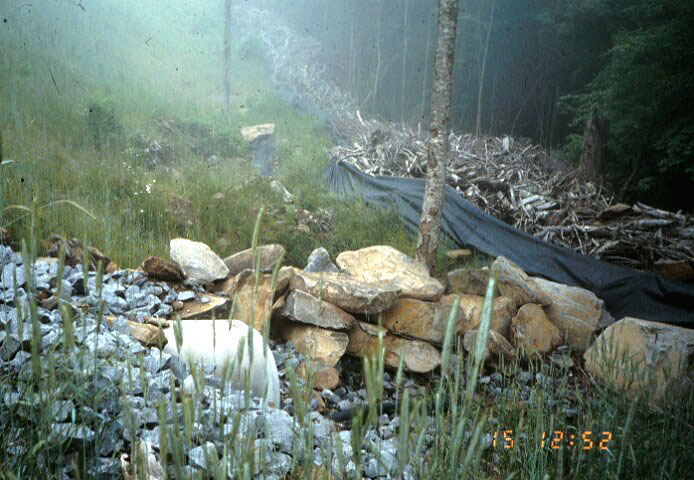
|
|
Cross drain pipe inlet dented during maintenance operation contributes to deposition in inlet basin.
|
Ditch relief culvert failure due to crushed pipe inlet.
|
|
Concrete cross drain pipe resists corrosion and damage.
|
Instability Below Outlet
| Important Site/Road Conditions |
Possible Treatments |
Specialist |
Reference/Definition |
Geology
Climate
Topography
Vegetation
Template
|
Replace/realign/move culvert |
Engineer |
Consult Engineer. |
| Construct retaining wall |
Geotechnical Engineer |
Prop unstable slope. |
| Outlet downspout |
Engineer, Hydrologist |
Protect unstable area. |
|
INSTABILITY BELOW THE OUTLET
|
|
PROPER DRAINAGE PROVISION
|

|

|
|

|

|
|
Ditch relief culvert outlet “shotgunned” due to fillslope erosion and instability.
|
|
Rock retaining wall to increase stability of fill over ditch relief culvert.
|
Member of a set of closely spaced ditch relief culverts minimizes affects to surroundings.
|
Outlet Scour
| Important Site/Road Conditions |
Possible Treatments |
Specialist |
Reference/Definition |
Geology
Climate
Topography
Vegetation
|
Harden outfall |
Engineer |
Rock rip-rap or outlet downspout to protect receiving area. |
| Add ditch relief |
Engineer, Hydrologist |
Reduce flow onto unstable area. |
| Replace/realign/move culvert (consult engineer) |
Engineer |
Move pipe so outflow is onto stable area. |
|
OUTLET SCOUR
|
|
PROPER DRAINAGE PROVISION
|

|
|

|

|

|
|
Scour at ditch relief culvert outlet.
|
|
Dry laid rock masonry with sill built by CCC reduces outlet scour.
|
Member of a set of closely spaced ditch relief culverts minimizes affects to surroundings.
|
Inadequate Pipe Cover
| Important Site/Road Conditions |
Possible Treatments |
Specialist |
Reference/Definition |
Template
Access
|
Ramp over pipe |
Engineer, Hydrologist |
Place additional material over pipe installation. |
| Reduce loss of fines/erosion over pipe |
Maintenance Foreman |
Properly maintain roadbed to reduce erosion. |
|
INADEQUATE PIPE COVER
|
|
PROPER DRAINAGE PROVISION
|

|

|

|
|

|
|
Inadequate cover over pipe.
|
Inadequate cover over corrugated metal pipe approximately 0.15m (6 in) deep where 0.3m (12 in) is required.
|
Inadequate cover over pipe.
|
|
Ample cover on ditch relief culvert.
|
Channel Impacts/Increased Drainage Density
Erosion
| Important Site/Road Conditions |
Possible Treatments |
Specialist |
Reference/Definition |
Geology
Climate
Topography
Vegetation
Biology
Template
Grade
Access
|
Slow and disperse water flows |
Engineer, Hydrologist |
Traveled Way Surface Shape, The X-DRAIN Cross-Drain Spacing and Sediment Yield Model, Introduction to Surface Cross Drains |
| Vegetation |
Biologist, Forester, Range Conservationist |
Vegetate eroding areas. |
| Gully Treatments |
Engineer, Hydrologist, Geologist |
Use vegetative and/or mechanical treatments to reduce gully erosion. |
| Diversion prevention dip |
Engineer, Hydrologist |
Diversion Potential at Road-Stream Crossings |
| Reduce contributing area |
Engineer, Hydrologist |
Traveled Way Surface Shape, The X-DRAIN Cross-Drain Spacing and Sediment Yield Model, Introduction to Surface Cross Drains |
|
EROSION
|
|
PROPER DRAINAGE PROVISION
|

|
|

|

|
|
Gully erosion resulting in increased drainage density due to excess surface water concentration from traveled way.
|
|
Elevated CMP inlet/elbow encourages ponding, deposition, and soil moisture recharge, while buffering downstream flows and reducing erosion.
|
Successful seeding and revegetation reduces erosion and channel development upstream of a road drainage structure.
|
Sedimentation
| Important Site/Road Conditions |
Possible Treatments |
Specialist |
Reference/Definition |
Geology
Climate
Topography
Vegetation
Biology
Template
Grade
Access
Policy
|
Vegetation |
Biologist, Forester, Range Conservationist |
Use vegetation to reduce sediment transport. |
| Gully treatments |
Engineer, Hydrologist, Geologist |
Use gully plugs to increase deposition in desired locations. |
| Sedimentation ponds |
Engineer, Hydrologist, Biologist |
Use sedimentation ponds to increase deposition in desired locations. |
|
SEDIMENTATION
|
|
PROPER DRAINAGE PROVISION
|

|

|
|

|
|
Deposition upstream of road stream crossing due to inadequate pipe capacity.
|
Channel bottom clogged with light cinder surfacing from road.
|
|
Sedimentation pond causes deposition in desired location and protects downstream areas.
|
Hydrologic Connectivity
| Important Site/Road Conditions |
Possible Treatments |
Specialist |
Reference/Definition |
Geology
Climate
Topography
Vegetation
Biology
Template
|
Slow and disperse water flows |
Engineer, Hydrologist |
Traveled Way Surface Shape, The X-DRAIN Cross-Drain Spacing and Sediment Yield Model, Introduction to Surface Cross Drains |
| Vegetation |
Biologist, Forester, Range Conservationist |
Use vegetation to slow flows and stabilize soil. |
| Desynchronize flows |
Engineer, Hydrologist |
Traveled Way Surface Shape, The X-DRAIN Cross-Drain Spacing and Sediment Yield Model, Introduction to Surface Cross Drains |
| Reduce contributing area |
Engineer, Hydrologist |
Traveled Way Surface Shape, The X-DRAIN Cross-Drain Spacing and Sediment Yield Model, Introduction to Surface Cross Drains |
| Gully treatments |
Engineer, Hydrologist |
Treat gullies with plugs, vegetation, biotechnical, mechanical methods. |
|
HYDROLOGIC CONNECTIVITY
|
|
PROPER DRAINAGE PROVISION
|
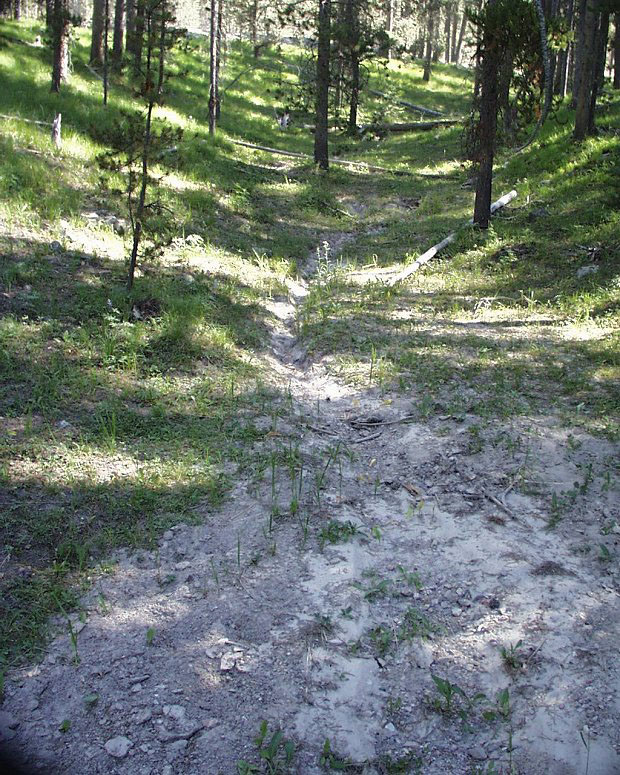
|
|

|

|
|
Hydrologic connectivity between road and stream due to surface water concentration and flow off road.
|
|
Gullying in area adjacent to road due to hydrologic connectivity successfully treated, with area healing.
|
Reduced Moisture
| Important Site/Road Conditions |
Possible Treatments |
Specialist |
Reference/Definition |
Geology
Climate
Topography
Vegetation
Biology
Template
Grade
Access
|
Slow and disperse water flows |
Engineer, Hydrologist |
Traveled Way Surface Shape, The X-DRAIN Cross-Drain Spacing and Sediment Yield Model, Introduction to Surface Cross Drains |
| Vegetation |
Biologist, Forester, Range Conservationist |
Use of vegetation to increase soil moisture recharge. |
| Retain moisture on site |
Engineer, Hydrologist |
Perform treatments to reduce loss of moisture from site. |
|
REDUCED MOISTURE
|
|
PROPER DRAINAGE PROVISION
|

|
|

|
|
Site drying and groundwater table lowered due to gullies caused by pipes installed below meadow elevation.
|
|
Proper drainage provision built and maintained into road encourages ponding and recharge of soil moisture.
|
Channel Encroachment From Road Alignment in Channel/Flood Plain
Loss of Road Prism
| Important Site/Road Conditions |
Possible Treatments |
Specialist |
Reference/Definition |
Geology
Climate
Topography
Vegetation
Biology
Template
Grade
Access
Policy
|
Realign road |
Inter-disciplinary Team |
Move road away from stream. |
| Install retaining structure |
Geotechnical Engineer |
Retain and protect fill from erosion. |
| Harden fillslope |
Engineer |
Protect fill from washout. |
| Realign stream |
Inter-disciplinary Team |
Move stream away from road. |
| Barbs/revetments (consultation) |
Engineer, Hydrologist, Biologist |
Reduce erosion, encourage deposition. |
|
LOSS OF ROAD PRISM
|
|
PROPER DRAINAGE PROVISION
|

|

|
|

|

|
|
Erosion of the fillslope due to channel encroachment by the road prism.
|
Erosion of road prism from channel encroachment.
|
|
Fillslope retaining wall prevents channel encroachment.
|
Bank barbs placed in channel prevent erosion and encourage deposition, protecting the road prism.
|
Channel Erosion
| Important Site/Road Conditions |
Possible Treatments |
Specialist |
Reference/Definition |
Geology
Climate
Topography
Vegetation
Biology
|
Realign road |
Inter-disciplinary Team |
Move road away from stream. |
| Protect channel banks (bioengineering) |
Engineer, Hydrologist, Biologist |
Vegetative and structural protection. |
| In-channel structure |
Engineer, Hydrologist |
Reduce erosion, encourage deposition. |
|
CHANNEL EROSION
|
|
PROPER DRAINAGE PROVISION
|

|

|
|

|
|
Channel erosion downstream of road/stream crossing structure.
|
Channel bank erosion worsened by road prism encroachment in channel.
|
|
Sufficient buffer between road and stream to prevent impacts to stream and fish habitat.
|
Sedimentation
| Important Site/Road Conditions |
Possible Treatments |
Specialist |
Reference/Definition |
Geology
Climate
Topography
Vegetation
Biology
|
Consult Biologist |
Biologist, Hydrologist |
N/A |
| Barbs/revetments (consultation) |
Engineer, Biologist |
Encourage deposition in desired areas. |
|
SEDIMENTATION
|
|
PROPER DRAINAGE PROVISION
|

|

|
|

|
|
Material eroded from top of fill ends up in stream and degrades fish habitat.
|
Deposition of light cinder surfacing in channel downslope of road alignment encroaching in channel.
|
|
Sufficient buffer between road and stream to prevent impacts to stream and fish habitat.
|
Channel Encroachment
| Important Site/Road Conditions |
Possible Treatments |
Specialist |
Reference/Definition |
Geology
Climate
Topography
Vegetation
Biology
Access
Policy
|
Realign road |
Inter-disciplinary Team |
Move road away from stream. |
| Realign stream |
Inter-disciplinary Team |
Move stream away from road. |
|
CHANNEL ENCROACHMENT
|
|
PROPER DRAINAGE PROVISION
|

|

|
|

|
|
Channel encroachment by road prism fillslope.
|
|
Sufficient buffer between road and stream to prevent impacts to stream and fish habitat.
|
Over Steepend Stream Channels
| Important Site/Road Conditions |
Possible Treatments |
Specialist |
Reference/Definition |
Geology
Climate
Topography
Vegetation
Biology
Access
Policy
|
Realign road |
Inter-disciplinary Team |
Move road away from stream. |
| Realign stream |
Inter-disciplinary Team |
Move stream away from road. |
| Barbs/revetments (consultation) |
Engineer, Hydrologist, Biologist, Geologist |
Reduce erosion, encourage deposition. |
| In channel structure |
Engineer, Hydrologist, Biologist |
Reduce erosion, encourage deposition. |
|
OVER STEEPENED STREAM CHANNELS
|
|
PROPER DRAINAGE PROVISION
|

|
|
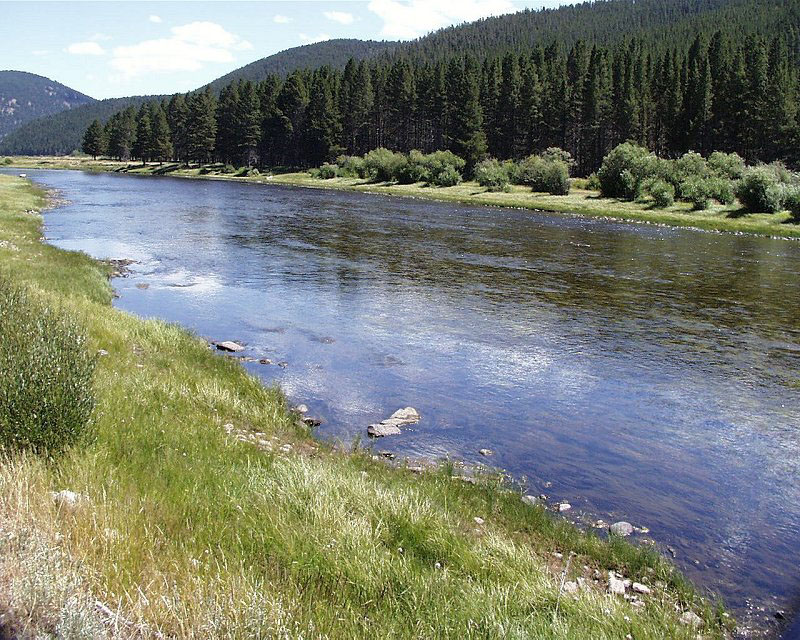
|
|
Stream channel steepened, straightened, and shortened due to channel encroaching fill.
|
|
Sufficient buffer between road and stream to prevent impacts to stream and fish habitat.
|
Isolation of Flood Plain From Stream
| Important Site/Road Conditions |
Possible Treatments |
Specialist |
Reference/Definition |
Climate
Topography
Biology
Access
Policy
|
Realign road |
Inter-disciplinary Team |
Move road out of flood plain. |
| Realign stream |
Inter-disciplinary Team |
Move stream away from road. |
|
ISOLATION OF FLOOD PLAIN FROM STREAM
|
|
PROPER DRAINAGE PROVISION
|

|
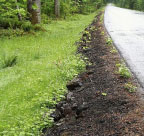
|
|

|
|
View looking away from road at flood plain isolated by turnpike road prism.
|
Turnpike road fill causing isolation of flood plain.
|
|
Sufficient buffer between road and stream to prevent impacts to stream and fish habitat.
|
Road/Stream Crossing Problems
Inlet Plugging
| Important Site/Road Conditions |
Possible Treatments |
Specialist |
Reference/Definition |
Geology
Vegetation
Biology
|
Remove organic debris |
Maintenance Foreman |
Clean channel and upslope areas of debris. |
| Shape, maintain, clean entrance |
Maintenance Foreman, Engineer |
Unplug inlet, shape entrance to optimize drainage. |
| Trash rack, debris rack |
Engineer |
Install rack to prevent plugging of inlet by debris. |
| Stand pipe w/drop inlet |
Engineer, Hydrologist, Biologist |
Stand pipe with drop inlet provides overflow protection in case structure inlet becomes plugged with debris. |
|
INLET PLUGGING
|
|
PROPER DRAINAGE PROVISION
|

|
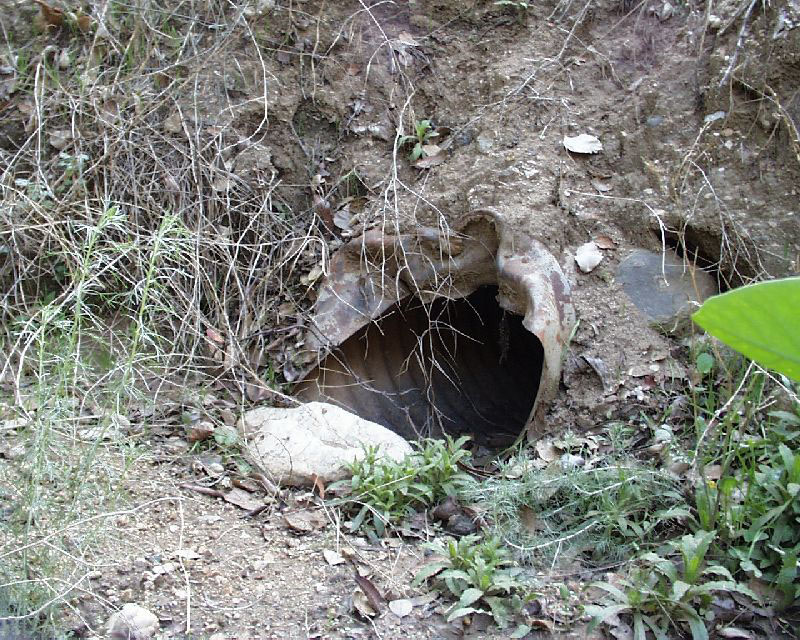
|
|

|

|
|
Road stream crossing culverts plugged with debris, leading to scour of the fillslope.
|
Inlet is partially plugged by rock and is dented by maintenance equipment.
|
|
Stand pipe with drop inlet overflow protection in debris laden stream.
|
Removable grid on cast in place culvert provides easy cleaning of debris from drainage crossing structure.
|
Enlarged Inlet Basin
| Important Site/Road Conditions |
Possible Treatments |
Specialist |
Reference/Definition |
Geology
Climate
Topography
Vegetation
Biology
Template
Policy
|
Shape/maintain/clean basin |
Maintenance Foreman |
Ensure basin geometry provides for passage of debris through structure. |
| Entrance treatment |
Engineer |
Flared inlet enhances passage of debris. |
| Trash or debris rack |
Engineer |
Trash or debris rack keeps debris from plugging inlet. |
| Add drainage structure |
Engineer |
Added drainage structure provides overflow in case inlet becomes plugged. |
| Stand pipe with drop inlet |
Engineer |
Stand pipe with drop inlet provides overflow in case inlet becomes plugged. |
|
ENLARGED INLET BASIN
|
|
PROPER DRAINAGE PROVISION
|

|
|

|
|
Large, open inlet basin encourages blockage of pipe inlet with debris.
|
|
Tapered inlet basin enhances passage of bedload and woody debris.
|
Stream Diversion
| Important Site/Road Conditions |
Possible Treatments |
Specialist |
Reference/Definition |
Geology
Climate
Topography
Vegetation
Biology
Template
Grade
Access
|
Diversion prevention dip |
Hydrologist, Engineer |
Diversion Potential at Road-Stream Crossings |
|
STREAM DIVERSION
|
|
PROPER DRAINAGE PROVISION
|

|
|

|

|
|
Potential stream diversion out of natural channel due to plugging and dented inlet.
|
|
Absence of stream diversion potential at road stream crossing drainage structure.
|
Construction of a dip to intercept overtopping flows and prevent diversion down the road or ditchline. This sketch depicts a diversion prevention dip on a low volume, low speed, single-lane road. The dip should intercept any ditchline present, and be of sufficient capacity to handle the entire expected design peakflow. Special care should be exercised in constructing the beginning (upslope end) of the dip where the rediversion of streamflow back toward the channel must occur and persist.
|
Culvert Washout
| Important Site/Road Conditions |
Possible Treatments |
Specialist |
Reference/Definition |
Geology
Topography
Biology
Template
|
Harden Crossing |
Engineer, Hydrologist |
Provide erosion resistance to road stream crossing. |
| Increase flow capacity |
Engineer, Hydrologist |
Replace culvert with structure having greater capacity, add culvert, or install an entrance treatment to increase capacity. |
|
CULVERT WASHOUT
|
|
PROPER DRAINAGE PROVISION
|

|

|
|

|
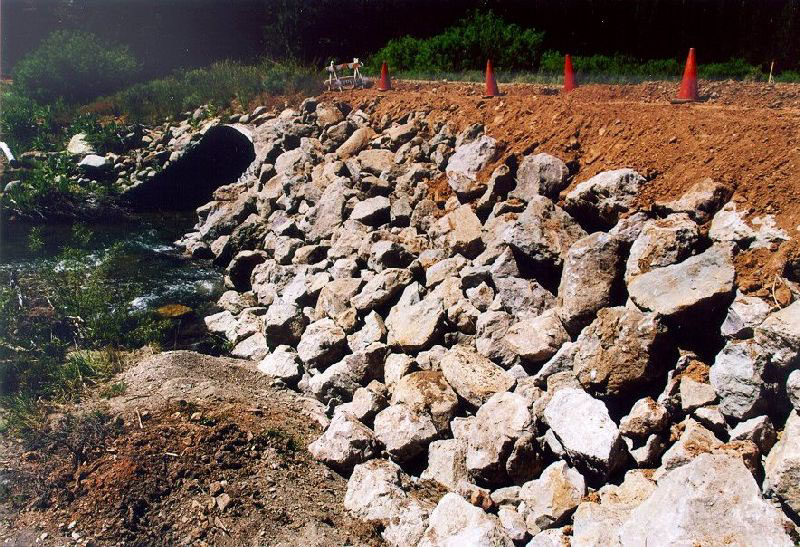
|
|
Road stream crossing culvert washout due to insufficient capacity.
|
Road stream crossing culvert washout due to lack of capacity.
|
|
Vented low water crossing with concrete pipe and fillslopes.
|
Road/stream crossing fillslope armored with rip-rap to resist culvert washout.
|
Culvert Piping
| Important Site/Road Conditions |
Possible Treatments |
Specialist |
Reference/Definition |
Geology
Climate
Biology
Template
|
Entrance treatment |
Engineer, Hydrologist |
Flared inlet can reduce or eliminate piping. |
| Rebed pipe |
Engineer |
Remove and reinstall pipe using proper bedding materials and procedures. |
|
CULVERT PIPING
|
|
PROPER DRAINAGE PROVISION
|

|
|

|
|
Streamflow piping around culvert can lead to embankment failure.
|
|
Properly bedded pipe prevents piping.
|
Corrosion/Drainage of Structure
| Important Site/Road Conditions |
Possible Treatments |
Specialist |
Reference/Definition |
Geology
Climate
Biology
Template
|
Replace pipe |
Engineer |
Remove damaged structure and install appropriate replacement. |
| Repair pipe |
Engineer |
Use cement grout or insert to extend life of damaged structure. |
|
CORRODED OR DAMAGED STRUCTURES
|
|
PROPER DRAINAGE PROVISION
|

|
|

|
|
Rusted pipe inverts cause piping and undermining of structure.
|
|
Cemented grout repair of abraded and corroded CMP invert.
|
Excessive Outlet Falls
| Important Site/Road Conditions |
Possible Treatments |
Specialist |
Reference/Definition |
Geology
Climate
Topography
Biology
|
Gully treatments |
Hydrologist, Engineer, Biologist, Geologist |
Install gully plugs or other treatments to prevent downcutting and encourage deposition. |
|
EXCESSIVE OUTLET FALLS
|
|
PROPER DRAINAGE PROVISION
|

|
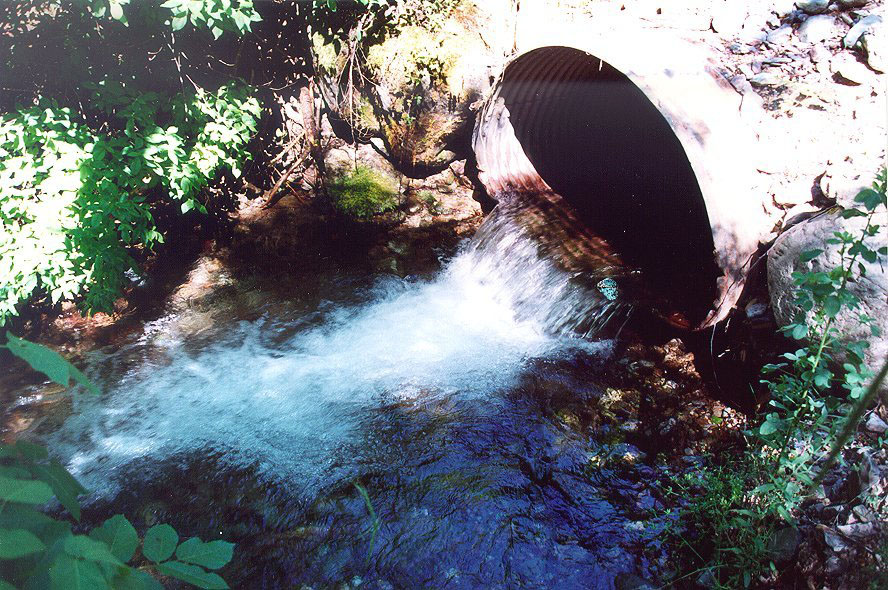
|
|
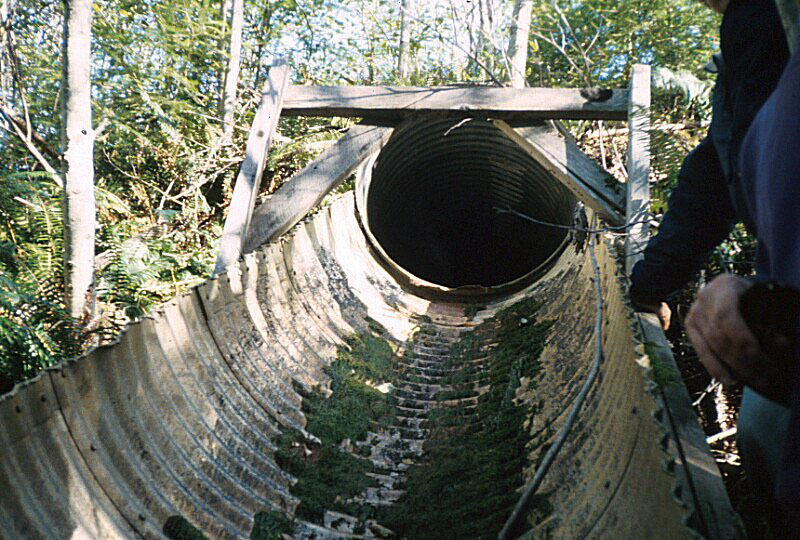
|

|
|
Channel erosion downstream of road/stream crossing structure.
|
|
Outlet half pipe to protect fillslope from erosion. Caution: this treatment can accelerate flow and increase downsteam erosion potential.
|
Ponded condition at road stream crossing drainage structure outlet reduces erosion potential.
|
Outlet Fillslope Erosion
| Important Site/Road Conditions |
Possible Treatments |
Specialist |
Reference/Definition |
Geology
Climate
Topography
Vegetation
Biology
|
Harden fillslope |
Engineer |
Gabions, cribs, retaining walls, concrete, pavement, or drainage structure extension. |
| Rebed pipe |
Engineer |
Remove and reinstall pipe at proper elevation using proper bedding materials and procedures. |
| Gully treatments |
Engineer, Hydrologist, Biologist, Geologist |
Install gully plugs or other treatments to prevent downcutting and encourage deposition. |
|
OUTLET FILLSLOPE EROSION
|
|
PROPER DRAINAGE PROVISION
|

|
|
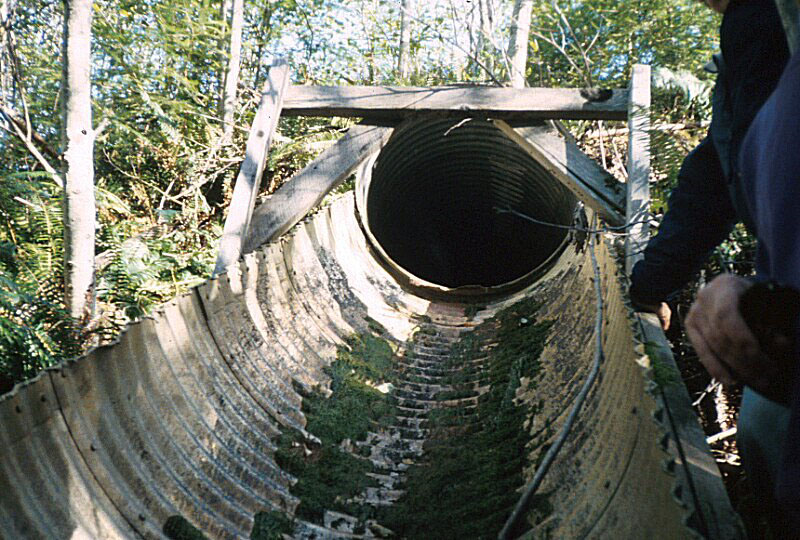
|

|
|
Low water crossing with scour and erosion of downstream side.
|
|
Outlet half pipe to protect fillslope from erosion. Caution: this treatment can accelerate flow and increase downstream erosion potential.
|
Road stream crossing culvert extending down fillslope to prevent erosion. Caution: this treatment can accelerate flow and increase downstream erosion potential.
|
Fish Passage Barriers
| Important Site/Road Conditions |
Possible Treatments |
Specialist |
Reference/Definition |
Climate
Topography
Biology
|
Rebed or replace pipe |
Engineer, Biologist |
Remove and reinstall pipe using proper bedding materials and procedures at proper inlet and outlet elevations. |
| Install fish passage structures |
Engineer, Biologist |
Baffles or fish ladders. |
|
FISH PASSAGE BARRIERS
|
|
PROPER DRAINAGE PROVISION
|

|

|
|

|

|
|
Water velocity causes road-stream crossing drainage structure to act as an aquatic species passage barrier.
|
Channel erosion downstream of road/stream crossing structure presents barrier to aquatic species passage.
|
|
Fish ladder.
|
Baffles in road stream crossing drainage structure encourage fish passage.
|
Inadequate Capacity
| Important Site/Road Conditions |
Possible Treatments |
Specialist |
Reference/Definition |
Climate
Template
|
Add drainage structure |
Engineer |
Increase flow capacity of crossing by additional structure. |
| Resize pipe |
Engineer |
Replace structure with larger capacity structure. |
| Entrance treatment |
Engineer |
Increase capacity by installing flared inlet. |
|
INADEQUATE CAPACITY
|
|
PROPER DRAINAGE PROVISION
|

|

|
|

|

|
|
Deposition upstream of road stream crossing due to inadequate pipe capacity.
|
Road/stream crossing drainage structure increasing velocity of stream flow.
|
|
Road stream crossing drainage structure sized to pass 100-year flow.
|
Drainage structures (2-24 inch CMP) added to increase crossing capacity.
|
Improper Alignment
| Important Site/Road Conditions |
Possible Treatments |
Specialist |
Reference/Definition |
Climate
Topography
Biology
Template
Grade
|
Realign pipe |
Hydrologist, Engineer |
Remove and reinstall pipe at proper alignment. |
|
IMPROPER ALIGNMENT
|
|
PROPER DRAINAGE PROVISION
|

|

|
|

|
|
Improper alignment of road stream crossing CMP lead to debris blockage problems.
|
|
Proper alignment of road stream crossing drainage structure.
|
Inlet Fillslope Erosion
| Important Site/Road Conditions |
Possible Treatments |
Specialist |
Reference/Definition |
Template
Grade
Access
|
Fillslope treatments |
Engineer |
Install gabions, cribs, retaining walls, to reduce or eliminate fillslope erosion. |
|
INLET FILLSLOPE EROSION
|
|
PROPER DRAINAGE PROVISION
|

|
|

|
|
Erosion of fillslope.
|
|
Rock filled gabion inlet fillslope protection.
|
Increased Hydraulic Energy
| Important Site/Road Conditions |
Possible Treatments |
Specialist |
Reference/Definition |
Climate
Topography
Biology
Template
|
Slow and disperse water flows |
Engineer, Hydrologist |
Traveled Way Surface Shape, The X-DRAIN Cross Drain Spacing and Sediment Yield Model, Introduction to Surface Cross Drains |
| Vegetation |
Biologist, Forester, Range Conservationist |
Use vegetation to slow flows. |
| Desynchronize flows |
Engineer, Hydrologist |
Traveled Way Surface Shape, The X-DRAIN Cross Drain Spacing and Sediment Yield Model, Introduction to Surface Cross Drains |
| Reduce contributing area |
Engineer, Hydrologist |
Traveled Way Surface Shape, The X-DRAIN Cross Drain Spacing and Sediment Yield Model, Introduction to Surface Cross Drains |
|
INCREASED HYDRAULIC ENERGY
|
|
PROPER DRAINAGE PROVISION
|

|
|

|

|
|
Road/stream crossing drainage structure increasing velocity of stream flow.
|
|
Elevated CMP inlet ponds water and reduces hydraulic energy of flows.
|
Successful seeding and revegetation of eroded area downstream of a road drainage structure reduces hydraulic energy of flows.
|
For Additional Information Contact:
Transportation Program Leader
San Dimas Technology & Development Center
444 East Bonita Avenue, San Dimas CA 91773-3198
Phone 909-599-1267; TDD: 909-599-2357; FAX: 909-592-2309
E-mail: mailroom_wo_sdtdc@fs.fed.us
Information contained in this document has been developed for the guidance of employees of the Forest Service, United States Department of Agriculture (USDA), its contractors, and cooperating Federal and State agencies. The USDA assumes no responsibility for the interpretation or use of this information by other than its own employees. The use of trade, firm, or corporation names is for the information and convenience of the reader. Such use does not constitute an official evaluation, conclusion, recommendation, endorsement, or approval of any product or service to the exclusion of others that may be suitable.
The U.S. Department of Agriculture (USDA) prohibits discrimination in all its programs and activities on the basis of race, color, national origin, sex, religion, age, disability, political beliefs, sexual orientation, or marital or family status. (Not all prohibited bases apply to all programs.) Persons with disabilities who require alternative means for communication of program information (Braille, large print, audiotape, etc.) should contact USDA's TARGET Center at (202) 720-2600 (voice and TDD).
To file a complaint of discrimination, write USDA, Director, Office of Civil Rights, Room 326-W, Whitten Building, 1400 Independence Avenue, SW, Washington, D.C. 20250-9410 or call (202) 720-5964 (voice and TDD). USDA is an equal opportunity provider and employer.
|








































































































































































